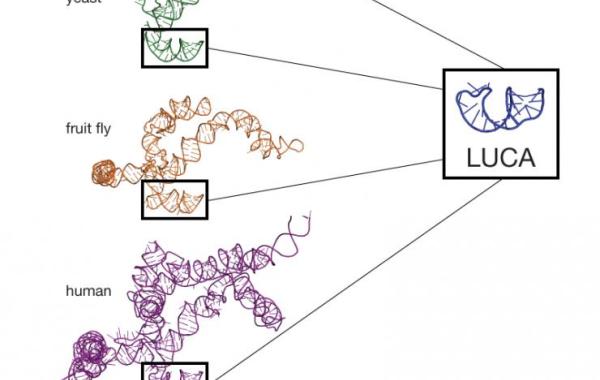Evolution of life's operating system revealed in detail

Ribosome evolution before and after the last universal common ancestor
The evolution of the ribosome, a large molecular structure found in the cells of all species, has been revealed in unprecedented detail in a new study.
Around 4 billion years ago, the first molecules of life came together on the early Earth and formed precursors of modern proteins and RNA. Scientists studying the origin of life have been searching for clues about how these reactions happened. Some of those clues have been found in the ribosome.
The core of the ribosome is essentially the same in all living systems, while the outer regions expand and become complicated as species gain complexity. By digitally peeling back the layers of modern ribosomes in the new study, scientists were able to model the structures of primordial ribosomes.
“The history of the ribosome tells us about the origin of life,” said Loren Williams, a professor in the School of Chemistry and Biochemistry at the Georgia Institute of Technology. “We have worked out on a fine level of detail how the ribosome originated and evolved.”
The study was sponsored by the NASA Astrobiology Institute and the Center for Ribosomal Origins and Evolution at Georgia Tech. The results were published June 30 in the journal Proceedings of the National Academy of Sciences.
In biology, the genetic information stored in DNA is transcribed into mRNA, which is then shipped out of the cell nucleus. Ribosomes, in all species use mRNA as a blueprint for building all the proteins and enzymes essential to life. The ribosome’s job is called translation.
The common core of the ribosome is essentially the same in humans, yeast, bacteria and archaea – in all living systems. The Georgia Tech team has shown that as organisms evolve and become more complex, so do their ribosomes. Humans have the largest and most complex ribosomes. But the changes are on the surface – the heart of a human ribosome the same as in a bacterial ribosome.
“The translation system is the operating system of life,” Williams said. “At its core the ribosome is the same everywhere. The ribosome is universal biology.”
In the new study, Williams and Research Scientist Anton Petrov compared three-dimensional structures of ribosomes from a variety of species of varying biological complexity, including humans, yeast, bacteria and archaea. The researchers found distinct fingerprints in the ribosomes where new structures were added to the ribosomal surface without altering the pre-existing core.
Additions to the ribosome cause insertion fingerprints. Much like a botanist can carve back twigs and branches on a tree to learn about its growth and age, Petrov and Williams show how segments were continually added to the ribosome without changing the underlying structure. The research team extrapolated the process backwards in time to generate models of simple, primordial ribosomes.
“We learned some of the rules of the ribosome, that evolution can change the ribosome as long as it does not mess with its core,” Williams said. “Evolution can add things on, but it can’t change what was already there.”
For a video on the origins and evolution of the ribosome, visit: https://www.youtube.com/watch?v=ei6qGLBTsKM
This research is supported by the NASA Astrobiology Institute under award number NNA09DA78A. Any conclusions or opinions are those of the authors and do not necessarily represent the official views of the sponsoring agency.
CITATION: Anton S. Petrov, et al., “Evolution of the Ribosome at Atomic Resolution.” (June 2014, PNAS) http://www.pnas.org/cgi/doi/10.1073/pnas.1407205111
Research News
Georgia Institute of Technology
177 North Avenue
Atlanta, Georgia 30332-0181 USA
@GTResearchNews
Media Relations Contacts: Brett Israel (@btiatl) (404-385-1933) (brett.israel@comm.gatech.edu) or John Toon (404-894-6986) (jtoon@gatech.edu)
Writer: Brett Israel
